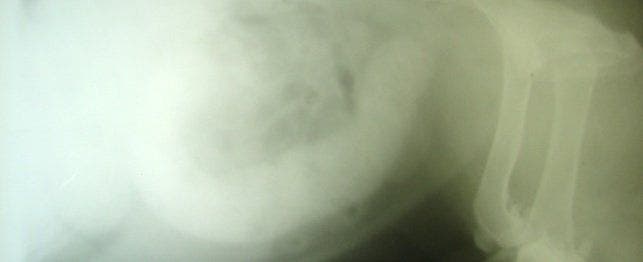
Obstipation and Megacolon in Dogs
Overview of Canine Obstipation and Megacolon
Constipation is a very common problem in dogs – especially in middle-aged to geriatric cats however it also happens in dogs. In medical terms, it’s defined as the difficult evacuation of feces from the colon (the large intestine), an issue that most pet owners will have some experience with.
But when the constipation recurs frequently and severely despite all veterinary efforts to control it, the disease process is referred to as obstipation. Obstipation effectively denotes a permanent loss of normal function of the large intestine.
Most veterinary patients who suffer from obstipation are cats (though dogs can suffer it, too). Their large intestines seem most inclined to experience a loss of normal function that leads to obstipation. Unfortunately, this loss of function isn’t the only issue. That’s because ultimately, obstipation culminates in a syndrome called megacolon.
Megacolon is defined as the end result of extreme dilatation of the colon (typically after many bouts of obstipation but also as the result of one long struggle with this process).
In some cases, megacolon can happen after large amounts of stool have left it distended long enough to permanently damage the nerves there. Trauma to the pelvis resulting in a blockage of the stool’s normal passage is a common example of how this might happen. However, any disease that leads to the functional obstruction of fecal material can lead to megacolon.
Nonetheless, the cause of this extreme form of constipation we call megacolon (or megacolon syndrome) is considered idiopathic in the majority of cats. Which is to say we have no definitive understanding of why these dogs are so afflicted. Presumably, however, this is a disease of the smooth muscles of the colon and research into its cause is ongoing.
All breeds of dogs seem equally susceptible to constipation, obstipation and megacolon.
What to Watch For
The first sign of trouble in these cases usually manifests as simple constipation. Constipation will often be readily identified by owners who routinely monitor their dogs’ elimination habits.
Observant owners may note one of the following signs:
- Straining to defecate (remaining in a hunched position for longer than usual and exerting repeated abdominal effort)
- Production of less stool than normal
- Production of harder and/or drier stool than normal
- Defecating indoors
- Passing small amounts of liquid stool (with or without mucus and/or blood) intermittently with firm stools intermixed
With or without medical attention, dogs who suffer from the more severe form of this disease (obstipation and megacolon) will typically progress to where the following signs become evident on a recurring and largely unmanageable basis:
- Lack of appetite
- Vomiting
- Depression/lethargy
- Weight loss
- Dehydration
- Vomiting
Diagnosis of Obstipation and Megacolon in Dogs
Diagnosis of constipation is typically achieved by owner observation of one or more of the above signs, physical examination revealing firm stool in the abdomen, and/or X-rays that elucidate the problem.
Diagnosis of obstipation and megacolon, however, typically require a longer history of recurrent issues or evidence of underlying issues leading to the disorder.
The following tests and procedures may be undertaken as part of the diagnostic process:
- Physical examination
- Neurological examination
- CBC (complete blood count)
- Chemistry (biochemical screen)
- Urinalysis
- X-ray
- Barium study
- CT scan
- Endoscopy (colonoscopy)
- Biopsy
Treatment of Obstipation and Megacolon in Dogs
Treatment of obstipation and megacolon is currently viewed as one of the few examples of a severe medical ailment for which a surgical option is considered curative. The subtotal colectomy procedure is considered the gold standard approach for this devastating condition. The following medical approaches, however, are often undertaken in advance of surgery:
- Enemas and removal of feces on a routine basis
- Frequent hydration (intravenously or subcutaneously)
- High fiber diets
- Psyllium, canned pumpkin or other sources of fiber
- Petroleum jelly or other laxatives
- Lactulose (a benign sugar syrup that works to draw water into the colon and moisten stool)
- Cisapride (a drug designed to promote smooth muscle contraction and get the colon working again)
Subtotal colectomy, however, remains the mainstay of treatment for most sufferers. Its goal is to remove much of the large intestine and thereby eliminate the organ that’s to blame for the signs dogs display.
Unfortunately, this procedure has its down-side, primarily in its high expense (due to its highly specialized nature it should be performed by a board-certified surgeon) and inherently less-than-optimal results.
Those who undergo it will typically suffer chronic loose stool as a result. These patients must receive dedicated home-care for the remainder of their lives. In spite of the drawbacks, they are, however, typically considered happy, healthy cats after their ordeal has concluded.
Sadly, due to the high expense and significant side-effects inherent to this procedure, euthanasia is a common outcome of this disease.
Veterinary Cost
The cost of treatment for obstipation and megacolon depends largely on how quickly the disease reaches its latest stages. That’s because it’s typically only at this point that owners will consent to surgical management of the disease and battling bouts of obstipation can be expensive (anywhere from $500 to $5,000).
Surgical treatment of this condition typically costs anywhere from $2,000 to $6,000. Teaching institutions and specialty centers are more likely to charge higher sums due to their higher quality of care.
Pet insurance can cover conditions including such as Obstipation and Megacolon.
Is Pet Insurance Right For You?
The best pet insurance offers coverage that’s broad enough for whatever care your pet needs and with enough options to get the perfect coverage for you and your pet.